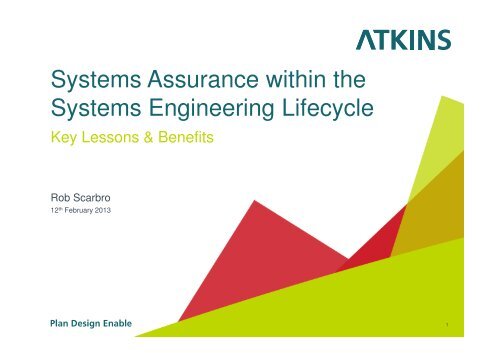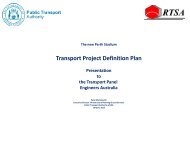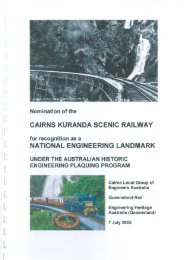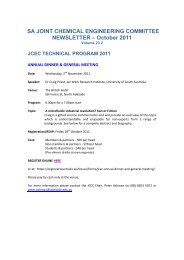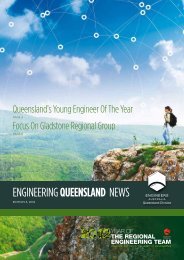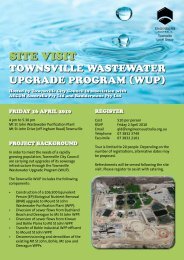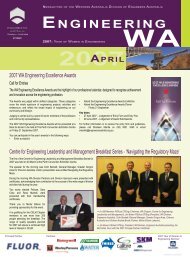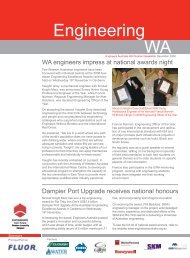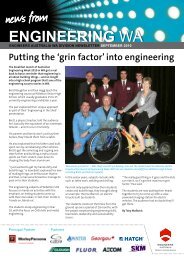Systems Assurance within the Systems Engineering Life Cycle
Systems Assurance within the Systems Engineering Life Cycle
Systems Assurance within the Systems Engineering Life Cycle
You also want an ePaper? Increase the reach of your titles
YUMPU automatically turns print PDFs into web optimized ePapers that Google loves.
<strong>Systems</strong> <strong>Assurance</strong> <strong>within</strong> <strong>the</strong><br />
<strong>Systems</strong> <strong>Engineering</strong> <strong>Life</strong>cycle<br />
Key Lessons & Benefits<br />
Rob Scarbro<br />
12 th February 2013<br />
1
Introduction<br />
•Overview of <strong>Systems</strong> <strong>Assurance</strong> across a Project <strong>Life</strong>-<br />
<strong>Cycle</strong><br />
•Key objectives, activities and outcomes for:<br />
• Concept / Feasibility<br />
• Detailed Design<br />
• Construction / Test & Commissioning<br />
•Summary of key benefits<br />
© Rob Scarbro 2013<br />
2
Overview of <strong>Systems</strong> <strong>Assurance</strong><br />
3
Overview of <strong>Systems</strong> <strong>Assurance</strong><br />
Area of Focus:<br />
Structured and systematic approach to ensuring <strong>the</strong> requirements related<br />
to reliability, availability, maintainability and safety.<br />
Drivers for <strong>Systems</strong> <strong>Assurance</strong>:<br />
•Work Health and Safety Act 2011 – Including Codes of Practice<br />
•Rail Safety National Law<br />
•Ensure Safety ‘So Far As Is Reasonably Practicable’<br />
•EN 50126:1999 – Railway applications – The specification and<br />
demonstration of Reliability, Availability, Maintainability and Safety<br />
(RAMS)<br />
•AS 4292 – Rail Safety Management<br />
•YB4 Yellow Book (withdrawn)<br />
© Rob Scarbro 2013<br />
4
<strong>Systems</strong> <strong>Assurance</strong> Requirements<br />
Quality of Service<br />
O<strong>the</strong>r Attributes<br />
Railway RAMS<br />
Safety<br />
Availability<br />
Reliability &<br />
Maintainability<br />
Operation &<br />
Maintenance<br />
Influence on RAMS<br />
RAMS<br />
System Condition Operating Condition Maintenance Condition<br />
The means used to achieve RAMS requirements are based on <strong>the</strong> concept of taking precautions to minimise <strong>the</strong> possibility of ane vent occurring<br />
as a result of an error during <strong>the</strong> lifecycle phases. Precaution is a combination of:<br />
Prevention: Concerned with lowering <strong>the</strong> probability of <strong>the</strong> impairment.<br />
Protection: Concerned with lowering <strong>the</strong> severity of <strong>the</strong> consequences of <strong>the</strong> impairment.<br />
© Rob Scarbro 2013<br />
5
<strong>Systems</strong> <strong>Assurance</strong> Across <strong>the</strong><br />
<strong>Systems</strong> <strong>Life</strong> <strong>Cycle</strong><br />
Part 2<br />
Part 1<br />
Part 3<br />
© Rob Scarbro 2013<br />
6
Part 1 Feasibility / Concept<br />
7
Key Objectives for Feasibility /<br />
Concept Phase<br />
• Development of scope and context of project<br />
• Development of Business Requirements<br />
• Sufficient activities to consider options to support planning and<br />
business case costing<br />
• Identify Key Stakeholders and interfaces<br />
• Develop requirements to enable contracts to be<br />
established<br />
• Clear, unambiguous requirements (including High Level RAMS<br />
requirements)<br />
• Aim to deliver options which will not place unacceptable constraints<br />
on <strong>the</strong> delivery entities<br />
© Rob Scarbro 2013<br />
8
Key Objectives for Feasibility /<br />
Concept Phase<br />
• Define Interfaces<br />
• Understand how <strong>the</strong> systems will all interact and integrate<br />
• Identify <strong>the</strong> Safety & Performance impact across interfaces<br />
• Identify Key Stakeholders<br />
• Understand Functionality<br />
• Develop Operations and Maintenance Concepts<br />
• Early understanding of functions to identify safety & performance<br />
critical functions<br />
• Focus on where effort should be e.g. critical areas of <strong>the</strong> design<br />
• Clearly understand <strong>the</strong> limits of <strong>the</strong> operating environment <strong>the</strong><br />
system will be intended to work<br />
© Rob Scarbro 2013<br />
9
Rail <strong>Systems</strong> Architecture<br />
© Rob Scarbro 2013 10
Key Activities during this Phase<br />
• RAM<br />
• High Level RAM requirements<br />
• Understanding of current network performance and key impacts on performance<br />
(Passengers, Fixed & Moving Assets)<br />
• Defining requirements which are clear, measurable, achievable by <strong>the</strong> contractor<br />
• Meaningful apportionment of Network level RAM requirements to <strong>the</strong> system under<br />
consideration<br />
• Options analysis to inform RAMS and through life cost requirements<br />
• <strong>Systems</strong> Safety<br />
• High Level Safety Requirements – Legal Compliance, SMS, Top Level Safety<br />
Requirements<br />
• Identification and assignment of interface safety requirements<br />
• Preliminary Hazard Analysis – Focus on novel to project, innovative, non-standard<br />
NOT what is already well known and understood<br />
• RAMS input into Options Development is essential, as <strong>the</strong> decision on options<br />
potentially become constraints to subsequent contractors, so must be<br />
demonstrable as considering safety SFAIRP<br />
© Rob Scarbro 2013<br />
11
Interface Management<br />
© Rob Scarbro 2013<br />
12
Outcomes at Concept / Feasibility<br />
•Structured, apportioned, measurable and achievable<br />
RAMS requirements<br />
•Objective evidence of a structured options process<br />
considering all risk associated with options<br />
•Safety <strong>Assurance</strong> of <strong>the</strong> 'Concept Design' – Demonstrating<br />
that decisions have not constrained <strong>the</strong> ability to manage<br />
safety SFAIRP<br />
•Operations, Maintenance and Through <strong>Life</strong> Concepts and<br />
Requirements<br />
© Rob Scarbro 2013<br />
13
Design Activities<br />
14
Key objectives during Design Phase<br />
•Clear and articulate road map to <strong>the</strong> achievement of<br />
RAMS in <strong>the</strong> detailed design development<br />
• <strong>Systems</strong> <strong>Assurance</strong> integral to design activities<br />
•Identify and capture objective evidence of a systematic<br />
and structured set of design activities, which:<br />
• Systematically Identify Hazards and design controls to eliminate, or<br />
engineer controls to manage safety SFAIRP;<br />
• Deliver an assured design which assures <strong>the</strong> optimal outcome for<br />
its end purpose to achieve <strong>the</strong> optimal solution to meet <strong>the</strong> RAMS<br />
requirements at <strong>the</strong> best Through <strong>Life</strong> Cost<br />
•Identify what success looks like (Pass/Fail criteria) for<br />
construction / manufacture (ITPs, tolerances, operating<br />
limits)<br />
© Rob Scarbro 2013<br />
15
Key Activities during this Phase<br />
• RAM<br />
• RAM Requirements and Analysis<br />
• FMECA<br />
• Corrective / Preventative Maintenance<br />
• RMDT Planning inc FRACAS<br />
• <strong>Systems</strong> Safety<br />
• Detailed Hazard Analysis<br />
• Fault Tree Analysis / Event Tree Analysis<br />
• Safety Case Development (inc. GSN Safety Argument)<br />
• Early identification / acceptance in principal of proposed operational<br />
and maintenance controls (assessment against O&M Concepts)<br />
© Rob Scarbro 2013 16
Outcomes at Design<br />
•Design demonstration that if built as designed, <strong>the</strong> RAMS<br />
requirements will be achieved in <strong>the</strong> operating environment<br />
(normal and degraded)<br />
•Design Safety Argument (or Safety Case) demonstrating<br />
that in Principal <strong>the</strong> Design has managed risk So Far As Is<br />
Reasonably Practicable<br />
•Inspection and Test Plans (ITPs) or equivalent developed<br />
to demonstrate how requirements will be demonstrated<br />
during construction / manufacture phase<br />
© Rob Scarbro 2013<br />
17
Taiwan High Speed<br />
© Rob Scarbro 2013<br />
18
Taiwan High Speed<br />
© Rob Scarbro 2013<br />
19
Taiwan High Speed<br />
© Rob Scarbro 2013<br />
20
Manufacturing / Construction<br />
21
Key Objectives for <strong>the</strong> Construction /<br />
Commissioning & Handover phase<br />
• Construction <strong>Assurance</strong><br />
● The ‘As Built’ meets <strong>the</strong> Design Intent<br />
● Requirements and specifications are verified and validated<br />
● Verification and Validation of RAMS Requirements<br />
● <strong>Engineering</strong> Change Management effectively manages configuration<br />
change from <strong>the</strong> design<br />
● Provision of structured, supported assurance case with physical and<br />
procedural objective evidence which supports <strong>the</strong> systems being<br />
accepted into operations and maintenance<br />
● Development of Operations and Maintenance Manuals and<br />
Operational Readiness<br />
© Rob Scarbro 2013<br />
22
Key <strong>Systems</strong> <strong>Assurance</strong> activities<br />
through Manufacturing/Construction<br />
Build / Manufacture <strong>Assurance</strong><br />
● Quality assurance of assets<br />
● Sub-System Testing – Factory Acceptance<br />
● Management of changes, re-assessment of RAMS, design changes to<br />
support change<br />
● Established FRACAS <strong>Systems</strong>, to records failures and rectify defects<br />
● Verification and Validation of RAMS Requirements<br />
● Safety Requirements Verification & Validation<br />
– Looking for objective evidence<br />
– Should be no doubt what <strong>the</strong> evidence of a requirement is<br />
– 100% V&V of Safety Requirements, traced to explicit Safety Controls <strong>within</strong><br />
<strong>the</strong> Hazard Log<br />
© Rob Scarbro 2013<br />
23
Summary<br />
• Top down approach understanding <strong>the</strong> network, systems<br />
and deriving RAMS requirements that lay <strong>the</strong> foundation for<br />
successful delivery<br />
• Engage RAMS from <strong>the</strong> outset of a project<br />
• RAMS activities are integrated engineering activities and<br />
support <strong>the</strong> design and construction delivering <strong>the</strong> required<br />
safety and integrity<br />
• Start with <strong>the</strong> end in mind and identify how <strong>the</strong> next phase<br />
will demonstrate requirements are met (ITPs etc)<br />
• Collation of structured objective evidence in a manner that<br />
enables an argument to be made of <strong>the</strong> overall assurance<br />
© Rob Scarbro 2013<br />
24
Any Questions?<br />
© Rob Scarbro 2013<br />
25


